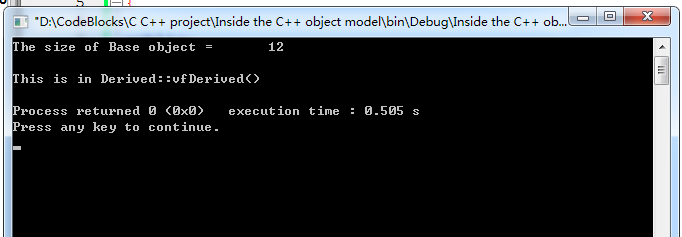内容概要:
满足下面2个条件时,
1. 父类无虚函数,子类有虚函数
2. 非虚继承
类对象之内存布局
如果将Base中的两个虚函数删除,情况有会怎么样呢?
将Base中的两个虚函数删除,其他保持不变。Base类和Derived类两者之间的关系如下:

代码如下:
#include <iostream> using namespace std; class Base { public: int m_base; /*inline virtual void vfBase_1() { cout << "This is in Base::vfBase_1()" << endl; } inline virtual void vfBase_2() { cout << "This is in Base::vfBase_2()" << endl; }*/ }; class Derived : public Base { public: int m_derived; inline virtual void vfDerived() { cout << "This is in Derived::vfDerived()" << endl; } }; typedef void (*VFun)(void); // 改为template形式,因为不能确定传进来的参数是Base类型的指针还是Derived类型的指针 template<typename T> VFun virtualFunctionPointer(T* b, int i) { return (VFun)(*((int*)(*(int*)b) + i)); } int main(void) { Derived d; cout << "The size of Base object = \t" << sizeof(Derived) << endl; cout << endl; int i = 0; while(virtualFunctionPointer(&d, i)) { VFun pVF = virtualFunctionPointer(&d, i++); pVF(); } return 0; }
运行结果如下:

Derived对象的memory layout图解如下:

这次由于Base类中不存在虚函数,所以在Derived类对象中的Base subobject就不会有vptr了,但Derived类中有虚函数,所以它的对象中就有vptr了。







 本文详细解析了类对象内存布局中虚函数的作用,通过修改Base类中的虚函数,展示了虚函数如何影响子类对象的内存布局,特别关注非虚继承的情况。通过代码示例和内存布局图解,深入理解虚函数在类继承中的应用。
本文详细解析了类对象内存布局中虚函数的作用,通过修改Base类中的虚函数,展示了虚函数如何影响子类对象的内存布局,特别关注非虚继承的情况。通过代码示例和内存布局图解,深入理解虚函数在类继承中的应用。


















 被折叠的 条评论
为什么被折叠?
被折叠的 条评论
为什么被折叠?








